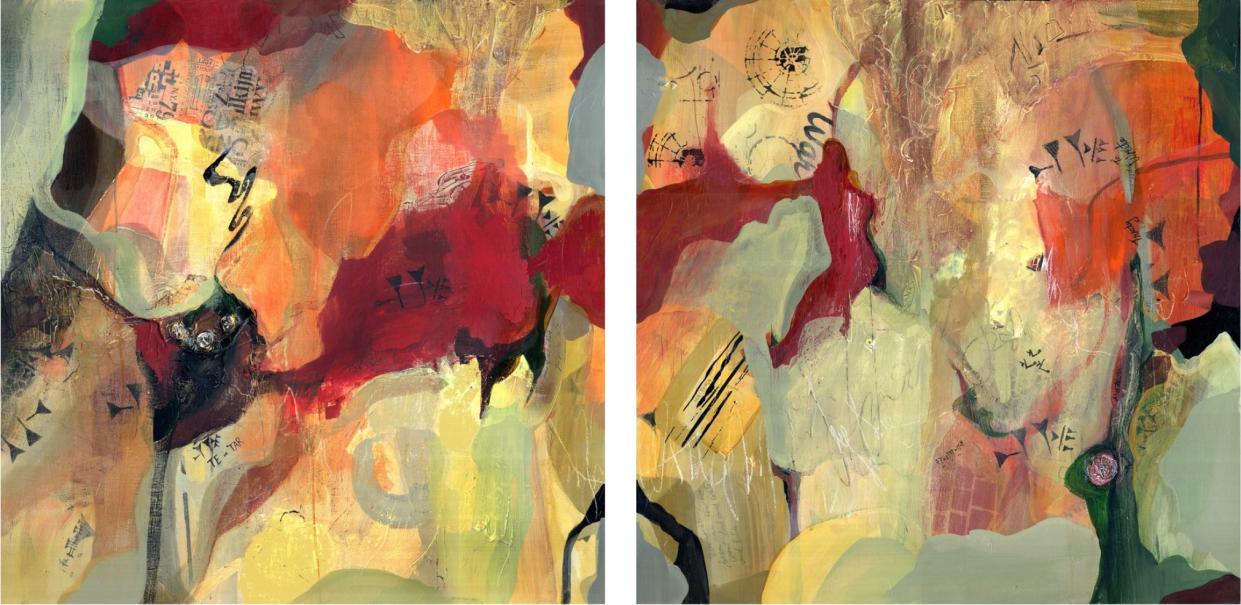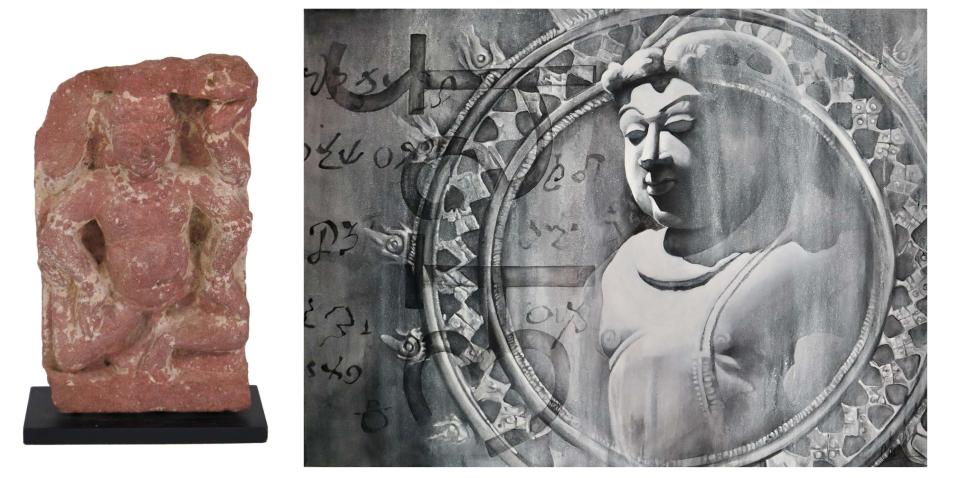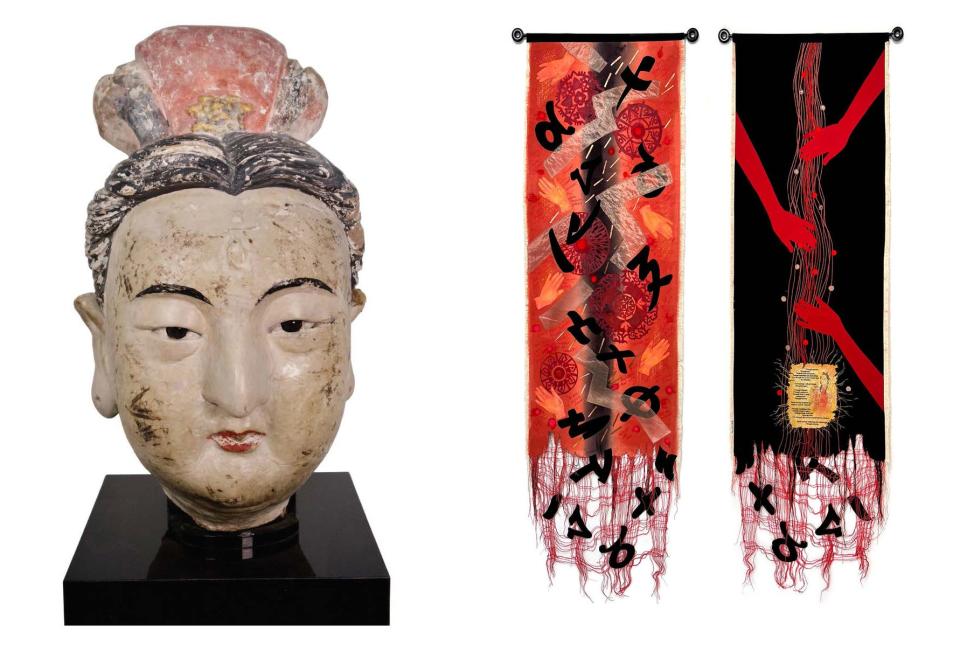Antiquities inspire new work by local artists in Sarasota gallery show

Art is not eternal, but it’s probably the closest that humanity can get. From the viewer's perspective, the art of the past exists in the present when you look at it. From a living artist’s perspective, a close encounter with ancient artwork could lead to a dialog with an ancient artist. Their end of the conversation takes the form of new work created in response to the old.
The living artist’s response might be a celebration of shared values and cultural heritage. It might also question the values of past artists – and offer a refutation, in the form of present-day creation.
The “Justified + Ancient” exhibition at MARA Art Studio + Gallery is designed to spark that conversation. It began with 16 ancient pieces on loan from an anonymous collector. Thanks to high-res photos, 16 artists from Sarasota and the Tampa Bay region let these art objects speak to them. The curators paired each artist with an artifact. This exhibition reveals both sides of this artistic dialog.
Arts Newsletter: Sign up to receive the latest news on the Sarasota area arts scene every Monday
Theater, concerts, dance, visual art: Your November guide to the arts in the Sarasota-Manatee area
Mary GrandPré: ‘Harry Potter’ illustrator talks new Sarasota abstract art show, retirement, J.K. Rowling

Mara Torres González’ work responds to two companion pieces from the 5th century BCE – the painted lids of two sarcophagi, one for the husband’s mummy, and one for his wife. The husband has the look of a nervous bureaucrat, but he’s honored with a three-dimensional representation, and an elaborate record of his life’s work, accompanied by illustrations of his earthly subjects and the Sphinx and other heavenly creatures. His wife is relegated to a flat (and not-too-competent) portrait, where her face is eternally in right profile. Her history is missing.
González’ “Valiant” series is her rebuttal to this patriarchal patronization. The artist describes these encaustic, photography and mixed-media pieces as “reflections of female energy.” “She is Life” is the largest and most striking image in this series. It’s a mixed-media painting of a female figure, exactly to scale with the woman depicted on the sarcophagus lid. González honors her with three-dimensionality and emblazons her with the Ankh, the ancient Egyptian symbol of the life force. Assuming the mummy is tired of facing right, she graciously allows her to face left.
Finding inspiration in ancient work

Grace Howl’s “Maya Modern” responds to three Mayan bowls of indeterminate dating. (3rd to the 12th century.) Miniature motifs of triangles, spirals, eyes and circular forms adorn the original, earth tone pieces. Howl’s painting magnifies these elements and reimagines them in living color. The playful result is symmetrical but not static. The Modernist promise of the painting’s title is far from empty. The eyes and orbs have the look of a Joan Miró painting or an Alexander Calder mobile. You do expect them to move.
Craig Thomas Marks speaks to a 3rd-century piece from the Gandhara region in what is now northwest Pakistan. The original artifact depicts a powerful, compassionate deity embedded in rough red rock. (It might be Kubera, the Hindu protector of the world. To my eye, Buddha is another possibility.) Marks’ “Oomkapiinaa” sets this beneficent being free. His monochromatic painting puts the figure in 3/4 profile, looking to the viewer’s left. It’s framed by the Hindu ring of fire and sacred Sanskrit text referring to peace and prosperity. The painting’s title refers to the Siksika (Blackfoot) term for Buddha. These indigenous peoples saw (and see) enlightenment as a community effort. Marks’ syncretistic storytelling lifts his liberating figure out of any culture, time, or belief system, and extends its compassion to every community.
Behind the Scenes: Hurricane recovery comes in stages with perspective
Getting personal: Ringling College shows sketch the public and private sides of art
A Q&A with Anita Wexler: Portrait of an archetypal artist

Jana Millstone’s “The Artist’s Hand” is a double-sided textile banner, dyed and embroidered by her own hand. Her work is a counterpoint to a bust of a female figure from the Yuan Dynasty (1260-1368 CE). The poker-faced image is taciturn — silent like any sculpture, though you imagine the actual subject was, too. Millstone evokes the woman’s unspoken feelings with a waterfall of reaching hands, ribbons of light, and calligraphic forms. She also gives the woman a voice in a poem woven into the artwork. According to Millstone, “My piece speaks of passing the baton of culture from one generation to another through the hands of artists.”
That’s only a sample of the strong artwork you’ll see here. Several artists took the attitude of jail breakers to ancient figures trapped in the formal images of busts, vases and sarcophagi. Their 21st-century pieces set them free in realms of color, dimension and movement. Many artists thought like archaeologists. Their pieces evoke the relentless layers of history — living civilizations building on top of dead civilizations, again and again, layer on layer, throughout time. Other artists didn’t dig so deep, and happily let their imaginations play around.
These living artists honor the ancient artists they’re responding to. That honor applies, even to this exhibit’s satiric work. Being lampooned is far better than being forgotten. After more than two millennia, an artist still remembers you? And even creates new art that speaks to yours?
That’s honor indeed.
“Justified + Ancient”
Presented by the Halo Arts Project and co-curated by Mara Torres and Jackie Cutrone. Through Nov. 17. MARA Art Studio + Gallery, 1421 5th Street, Sarasota; (941) 914-8110; MaraStudioGallery.com
This article originally appeared on Sarasota Herald-Tribune: Artists put a modern spin on antiquities in new Sarasota gallery show
